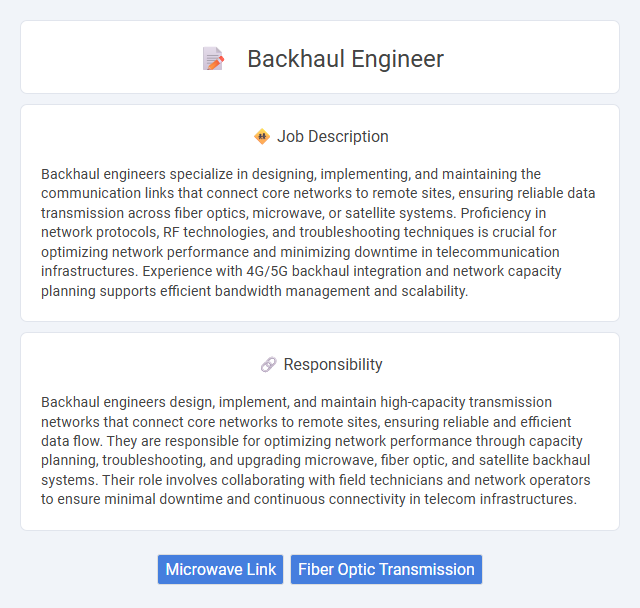
Backhaul engineers specialize in designing, implementing, and maintaining the communication links that connect core networks to remote sites, ensuring reliable data transmission across fiber optics, microwave, or satellite systems. Proficiency in network protocols, RF technologies, and troubleshooting techniques is crucial for optimizing network performance and minimizing downtime in telecommunication infrastructures. Experience with 4G/5G backhaul integration and network capacity planning supports efficient bandwidth management and scalability.
Individuals with strong analytical skills and a passion for network infrastructure are likely to thrive as Backhaul engineers, given the technical demands and problem-solving nature of the role. Those who prefer hands-on work and can manage stress effectively may find this career path suitable, whereas people who struggle with complex systems or high-pressure environments might face challenges. The job often involves working with evolving technologies and tight deadlines, suggesting a fit for adaptable and detail-oriented candidates.
Qualification
Backhaul engineers require a strong background in telecommunications engineering, with proficiency in designing, deploying, and maintaining wireless and fiber-optic backhaul networks. Essential qualifications include expertise in microwave radio systems, network protocols, and experience with technologies such as MPLS, SDH, and Ethernet. Certifications like Cisco CCNA or JNCIA alongside hands-on experience in troubleshooting and network optimization are highly valued in this role.
Responsibility
Backhaul engineers design, implement, and maintain high-capacity transmission networks that connect core networks to remote sites, ensuring reliable and efficient data flow. They are responsible for optimizing network performance through capacity planning, troubleshooting, and upgrading microwave, fiber optic, and satellite backhaul systems. Their role involves collaborating with field technicians and network operators to ensure minimal downtime and continuous connectivity in telecom infrastructures.
Benefit
Backhaul engineer roles likely offer competitive salaries due to the specialized nature of the work involving network infrastructure and data transmission. Benefits may include opportunities for professional growth in telecommunications and access to cutting-edge technology projects. Job stability is probable as backhaul engineers play a crucial role in maintaining and expanding communication networks.
Challenge
The Backhaul engineer role likely involves addressing complex network connectivity issues to ensure reliable data transmission over long distances. Challenges may include optimizing bandwidth capacity, managing latency, and maintaining link stability in diverse environmental conditions. Problem-solving under tight deadlines and adapting to evolving technologies could be frequent aspects of the job.
Career Advancement
Backhaul engineers specializing in designing and maintaining wireless and fiber optic networks experience significant career advancement opportunities as telecommunications companies expand 5G infrastructure. Mastery in network optimization, microwave link configuration, and fiber deployment positions engineers for roles such as senior network architect, project manager, or network operations director. Continuous certifications in networking protocols, RF engineering, and emerging 5G technologies accelerate promotions and leadership responsibilities in the telecom industry.
Key Terms
Microwave Link
A Backhaul Engineer specializing in Microwave Link is responsible for designing, deploying, and maintaining high-capacity wireless communication links that connect cellular base stations to the core network. Expertise in microwave radio frequencies, link budget calculation, and line-of-sight analysis ensures optimal network performance and minimal signal loss. Proficiency with equipment vendors such as Ericsson, Huawei, and Nokia, alongside troubleshooting RF interference and bandwidth optimization, is critical for successful backhaul network management.
Fiber Optic Transmission
Backhaul engineers specializing in fiber optic transmission design, implement, and maintain high-capacity fiber networks that connect core networks to remote sites, ensuring low latency and high bandwidth reliability. Their expertise includes fiber splicing, testing with OTDR equipment, and optimizing DWDM systems to maximize data transmission efficiency. Proficient in solving physical layer issues and upgrading infrastructure supports seamless 5G and broadband services across metropolitan and rural areas.
 kuljobs.com
kuljobs.com